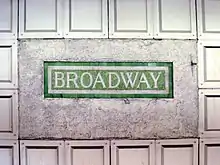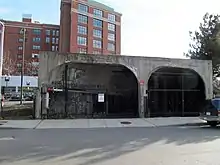Broadway station (MBTA)
Broadway station is a subway station in Boston, Massachusetts. It serves the MBTA's Red Line. It is located at the intersection of Dorchester Avenue and Broadway in South Boston. It was opened on December 15, 1917 as part of the Dorchester Extension from Downtown Crossing (formerly Washington station) to Andrew. The station has a single island platform to serve the two tracks.
Broadway | |||||||||||
|---|---|---|---|---|---|---|---|---|---|---|---|
 A southbound train at Broadway station in 2017 | |||||||||||
| Location | Dorchester Avenue at Broadway South Boston, Massachusetts | ||||||||||
| Coordinates | 42°20′34″N 71°03′26″W | ||||||||||
| Line(s) | Dorchester Tunnel | ||||||||||
| Platforms | 1 island platform | ||||||||||
| Tracks | 2 | ||||||||||
| Connections | |||||||||||
| Construction | |||||||||||
| Disabled access | Yes | ||||||||||
| History | |||||||||||
| Opened | December 15, 1917 | ||||||||||
| Rebuilt | 1985 | ||||||||||
| Passengers | |||||||||||
| FY2019 | 6,020 boardings (weekday average)[1] | ||||||||||
| Services | |||||||||||
| |||||||||||
History
Construction

After the Cambridge Tunnel was completed between Harvard and Park Street in 1912, work began to extend the line south to Dorchester. Rather than being opened all at once, the second section was opened station-by-station as soon as possible due to popularity. Extensions opened to Washington (Downtown Crossing) in 1915, South Station Under in 1916, and to Broadway on December 15, 1917. Broadway was the southern terminus of the line until Andrew opened on June 29, 1918.[2] With the exception of Park Street - which was built with three platforms to handle crowds - Broadway was the only station on the original Cambridge-Dorchester Tunnel with an island platform (rather than two side platforms) in order to facilitate transfers through its three levels. Not until the aboveground Columbia and Savin Hill stations opened in 1927 were there other island platforms used on the line.
Broadway station was originally built as a three-level station, with six stairways to allow easy transfer between streetcars and subway trains. Some streetcars stopped at a surface-level platform, others in a tunnel segment just below ground, while subway trains used the lowest-level tunnel. Each level consisted of two tracks and an island platform.[3] The street-level platform served streetcars that ran from the Tremont Street Subway to City Point and South Boston via the Pleasant Street Portal and Broadway, on the #9 streetcar line. Buses replaced the single line to Bay View (which originally used the middle-level tunnel segment) in 1929, but the City Point line lasted until March 1, 1953 before being bustituted.[3]
Renovations

In the mid-1980s, the MBTA spent $80 million to extend the platforms of seven underground Red Line stations and three Orange Line stations to allow the use of six-car trains.[4] Contracts for Broadway and three other stations were awarded on December 18, 1985, with a groundbreaking held on February 13, 1986.[5][6] The Broadway work cost $7.9 million, with the platform extended by 70 feet (21 m).[6] Six-car trains entered service on January 21, 1988.[2] A new entrance east of Dorchester Avenue opened on February 16, 1988, and the project was completed on October 26, 1989.[5] Elevators were installed during the project, making Broadway one of the first older stations on the system to be modified for accessibility.[7][6]
As part of the Arts on the Line program, two works of public art were installed:[8][9]
- Domestic Objects & Tools of the Trade by Jay Coogan: 60 enameled steel sculptures suspended over the platform stairs
- 200 engraved ceramic tiles by students at the nearby St. Brigid's School
The MBTA plans to add a third headhouse to the station at the intersection of Dorchester Avenue and West 4th Street, which will provide redundant elevator access to the station. The existing elevators will be rebuilt. A design contract was awarded in April 2020.[10]
Streetcar tunnel

The middle-level streetcar tunnel ran from a portal on Foundry Street south to another in the median of Dorchester Avenue. Service lasted for under two years' time, until October 14, 1919 - just after Andrew opened - since Andrew provided more convenient service to South Boston and eliminated unprofitable running on an industrial section of Dorchester Avenue.[11] The Dorchester Avenue portal was filled in December 1941, but much of the tunnel still exists.[11]
The streetcar tunnel saw several adaptive reuses. In the 1930s, the Boston Elevated Railway attempted to grow mushrooms in the tunnel, and in the 1980s it was used to test tactile platform edging for blind passengers.[12] The 1985-built fare lobby occupies a section of the old streetcar platform and tunnel. After the September 11th attacks focused attention on infrastructure safety preparedness, the MBTA used the tunnel to train firefighters to respond to a burning train.[12]
In mid 2012, the MBTA started construction on an $10 million emergency training center located in the old streetcar tunnel, to replace the previous equipment. The $8.8 million facility, paid for with Department of Homeland Security funding, includes two Blue Line and one Green Line cars plus a Silver Line bus. The first Blue Line car was lowered into the Foundry Street Portal by crane in September 2012.[13] The facility opened on June 12, 2013.[14]
References
- "A Guide to Ridership Data". MassDOT/MBTA Office of Performance Management and Innovation. June 22, 2020. p. 9.
- Belcher, Jonathan. "Changes to Transit Service in the MBTA district" (PDF). NETransit.
- O'Regan, Gerry (2005). "MBTA Red Line". NYCsubway.org. Retrieved 3 March 2012.
- 1985 Annual Report. Massachusetts Bay Transportation Authority. 1985. p. 13 – via Internet Archive.
- Sanborn, George M. (1992). A Chronicle of the Boston Transit System. Massachusetts Bay Transportation Authority – via Massachusetts Institute of Technology.
- Crocket, Douglas S. (February 14, 1986). "Broadway station work begins". Boston Globe. p. 22 – via Newspapers.com.

- Tran Systems and Planners Collaborative (August 24, 2007). "Evaluation of MBTA Paratransit and Accessible Fixed Route Transit Services: Final Report" (PDF). Massachusetts Bay Transportation Authority.
- Howe, Peter J. (April 27, 1988). "MBTA hopes riders will be transported by art". Boston Globe. pp. 21, 35 – via Newspapers.com. (second page)

- "On the Red Line" (PDF). Massachusetts Bay Transportation Authority. 2017. p. 9.
- Schwarz, John (April 13, 2020). "MBTA Contract Nos. A90PS02, A90PS04, & A90PS05: Architectural and Engineering Services for Station and Accessibility Improvements" (PDF). Massachusetts Bay Transportation Authority.
- Clarke, Bradley H. (2003). Streetcar Lines of the Hub. Boston Street Railway Association. p. 33. ISBN 0938315056.
- Bierman, Noah (26 December 2009). "Transit archeology: Tour of abandoned subway network offers a glimpse of how the T was built". Boston Globe. Retrieved 7 August 2013.
- Werthmann, Melissa M. (September 17, 2012). "Subway car is added to MBTA underground training facility for emergency workers". Boston Globe.
- Powers, Martine (June 12, 2013). "MBTA sets up disaster training center in tunnel". Boston Globe.
External links
| Wikimedia Commons has media related to Broadway station (MBTA). |